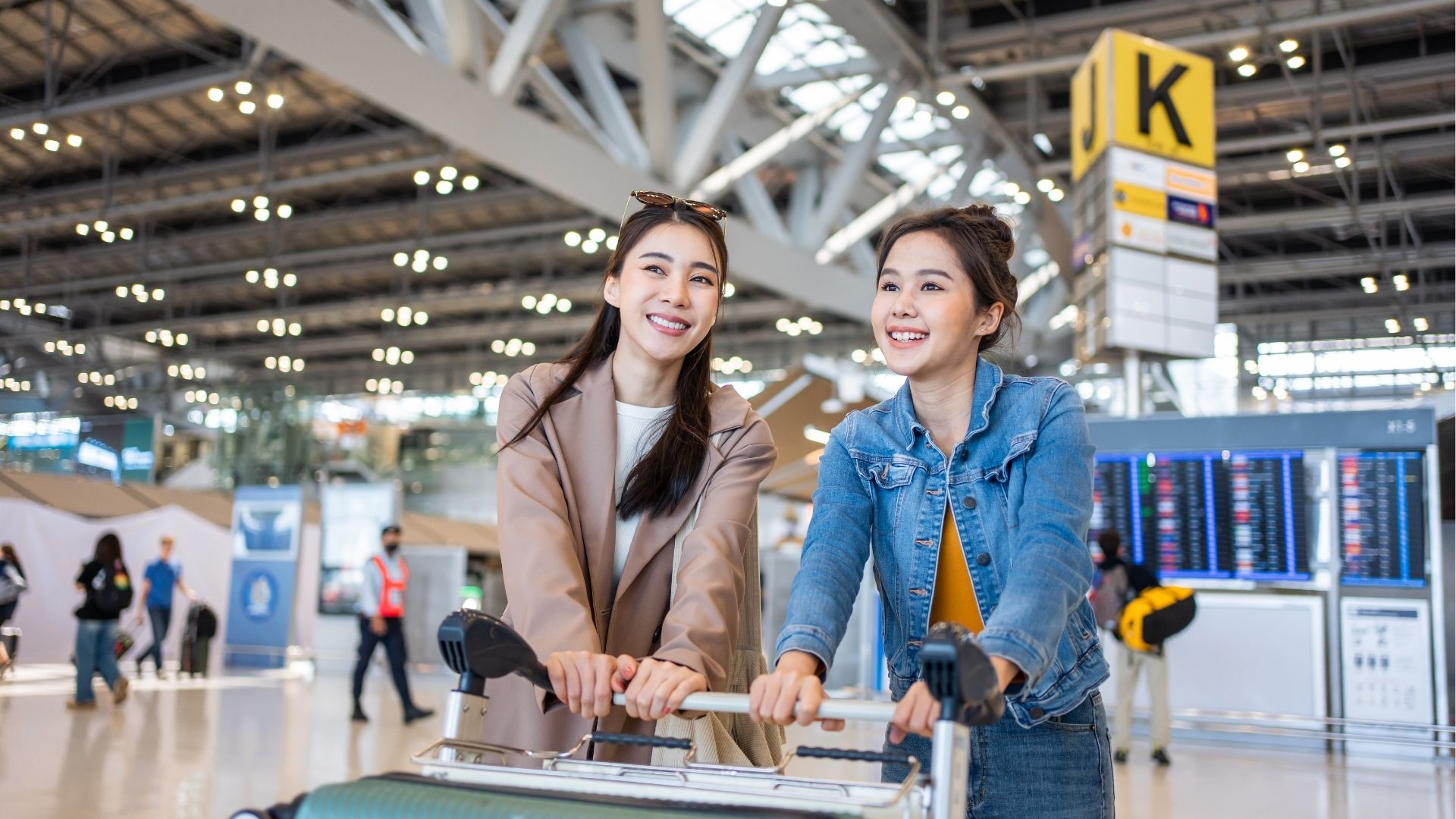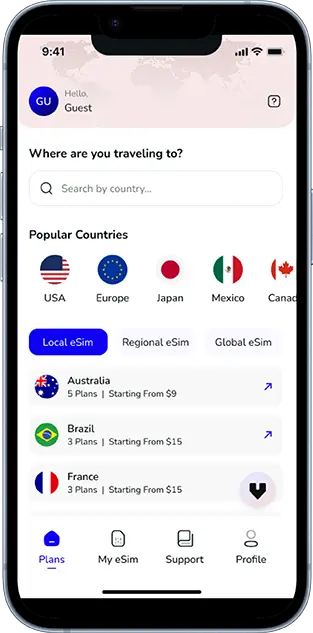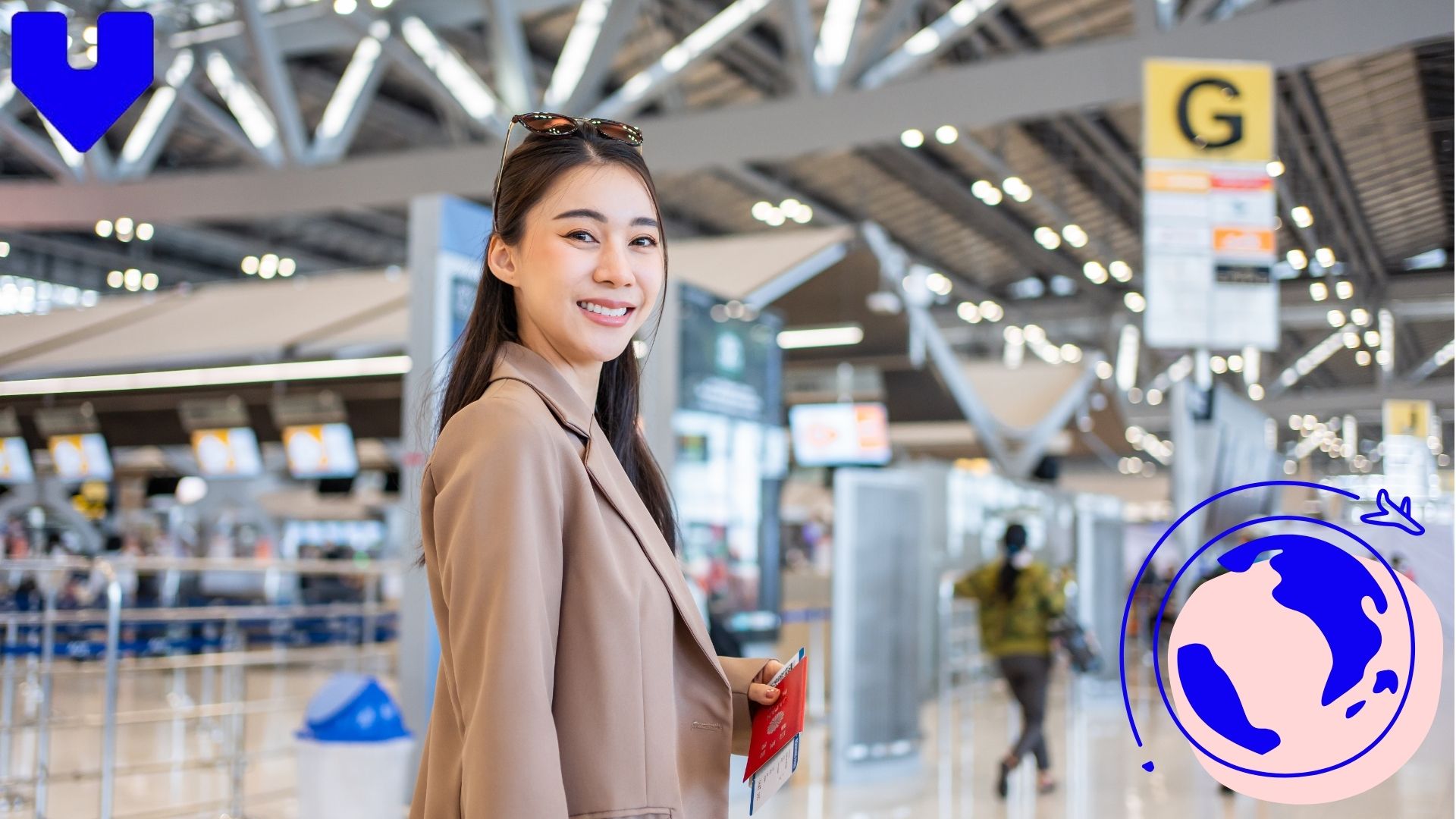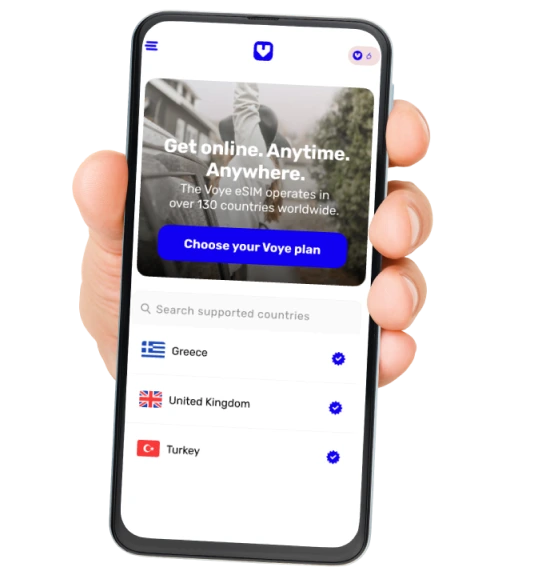Note that iPhone devices from Mainland China aren’t eSIM compatible. Also iPhone devices from Hong Kong and Macao aren’t compatible (except for iPhone 13 Mini, iPhone 12 Mini, iPhone SE 2020 and iPhone XS)
Every year, thousands of Japanese travelers pass through Thailand’s airports on their way to destinations across Asia, Europe, and beyond. With Bangkok’s Suvarnabhumi (BKK) and Don Mueang (DMK) airports serving as key transit hubs, Thailand has become a vital stopover point for long-haul journeys. Yet, many travelers still wonder: Do you need a visa just to transit through Thailand?
The good news is that Thailand offers traveler-friendly visa policies for Japanese citizens. Most short layovers don’t require a visa, and with 60-day visa-free entry, even longer stopovers or overnight connections are easily managed. Plus, Thailand is modernizing its entry process with the Thailand Digital Arrival Card (TDAC) and the upcoming Electronic Travel Authorization (ETA).
This guide explains everything Japanese travelers need to know about Thailand’s transit and visa rules – helping you move through Thai airports smoothly and stress-free.
Understanding Thailand’s Transit Visa Policy for Japanese Citizens
When flying between Japan and another international destination, many travelers connect through Bangkok’s Suvarnabhumi Airport (BKK) or Don Mueang Airport (DMK). For Japanese passport holders, understanding Thailand’s transit visa and visa exemption rules is key to ensuring a smooth journey without unexpected airport complications.
Visa-Free Entry (The 60-Day Exemption) for Japanese Citizens
Japan and Thailand share a strong bilateral relationship, which allows Japanese travelers to enjoy generous visa-free entry under the Visa Exemption Scheme.
Under the current Thai immigration policy (effective from July 15, 2024):
- Japanese citizens do not need a visa for stays of up to 60 days when entering Thailand by air for tourism or short visits. This 60-day stay can also be extended by an additional 30 days at an immigration office.
- For airside transit (without passing through immigration), if your layover is under 12 hours and your connecting flight is on the same booking, no visa is required.
- You must remain inside the international transit zone and hold a confirmed onward ticket to a third country.
Stay Connected Instantly
Activate your eSIM in seconds for hassle-free travel in Thailand.
When a Transit Visa (Category “TS”) Is Required
While most Japanese travelers can transit visa-free, you’ll need a Transit Visa (TS) in the following cases:
- If your layover exceeds 12 hours and you plan to leave the airport, even briefly.
- If you are transiting through two different Thai airports, such as arriving at Don Mueang (DMK) and departing from Suvarnabhumi (BKK).
- If your airline requires you to collect and recheck luggage, you must pass through immigration.
Note: If you leave the airport for an overnight stay but plan to remain in Thailand for fewer than 30 days, you can alternatively use the visa exemption instead of a Transit Visa.
Validity and Duration of the Thai Transit Visa
According to the Royal Thai Consulate-General in Osaka:
- The Transit Visa is valid for 3 months from the date of issue.
- It allows a stay of up to 30 days per entry.
- Travelers may apply for single or double entries, depending on their itinerary.
Common Scenarios for Japanese Travelers
Tokyo → Bangkok → Paris (same ticket, 8-hour layover)
- No Visa Needed
- You can stay airside for under 12 hours without entering Thailand.
Osaka → Bangkok (overnight stay) → Bali
- No Visa Needed
- You can enter Thailand under the 60-day visa-free exemption; a Transit Visa isn’t required.
Nagoya → Bangkok → Chiang Mai (domestic flight)
- No Visa Needed
- You’ll need to pass immigration for your domestic connection, but it’s covered by the 60-day visa exemption.
Tokyo → DMK → BKK → London
- Visa Required (for airport transfer)
- Since you’re transferring between two airports (DMK and BKK), you must clear immigration – but this is still covered by the 60-day visa exemption for Japanese citizens.
COVID-19 and Post-Pandemic Entry Notes
While Thailand has lifted all pandemic-era entry restrictions, Japanese travelers should still:
- Keep a printed copy of their onward flight itinerary and hotel booking if staying overnight.
- Verify airline-specific baggage and recheck rules, as these can affect whether you need to clear immigration.
- Allow extra time between flights during peak periods due to potential security queues.
Thailand no longer requires proof of vaccination, test results, or health insurance for transit or short-term stays.
Travel Smart, Stay Online
Enjoy high-speed data and easy setup with Voye Global eSIM.
Quick Tip
Many Japanese travelers use Bangkok as a convenient stopover between Asia and Europe. If you plan to enjoy a short city visit or stay overnight, make sure your itinerary fits under the 60-day visa exemption (which can be extended to 90 days). Requirements may vary slightly between airlines and consulates, so always confirm before departure.
Applying for a Thai Transit Visa – Step-by-Step Guide for Japanese Travelers
For most Japanese travelers whose stay does not exceed 60 days, the Visa Exemption scheme (detailed below) is the simpler option for overnight layovers or airport transfers.
The Thai Transit Visa (Category TS) is typically only necessary for Japanese citizens if your total stay in Thailand exceeds the 60-day visa-exempt period but is less than 90 days, or if you are specifically required to obtain this visa by an airline or for other non-tourist purposes. If you do need one, the process is straightforward.
Where to Apply
Japanese travelers can apply for a Thai Transit Visa at the following official offices:
- Royal Thai Embassy, Tokyo
Address: 3-14-6, Kami-Osaki, Shinagawa-ku, Tokyo 141-0021
Website: www.thaiembassy.jp - Royal Thai Consulate-General, Osaka
Address: 1-9-16 Kyutaromachi, Chuo-ku, Osaka 541-0056
Website: osaka.thaiembassy.org
Applications can be made:
- In person, by appointment (recommended).
- Through authorized visa agencies, if you can’t visit directly.
- Or online via Thailand’s official eVisa portal at www.thaievisa.go.th – available for most Japanese applicants.
Documents Required
To apply for a Thai Transit Visa, Japanese travelers should prepare the following:
- Valid Japanese passport – at least 6 months’ validity with 2 blank pages.
- Completed visa application form – available at the embassy or on the eVisa portal.
- One passport-sized photo (4×6 cm) – white background, taken within the last 6 months.
- Confirmed air tickets – showing entry into and onward departure from Thailand within 60 days.
- Proof of sufficient funds – at least 10,000 THB per person or 20,000 THB per family, via recent bank statement or cash proof.
- Visa fee – approximately ¥5,000 per single entry or ¥10,000 per double entry (subject to change).
- Accommodation booking or transit plan, if applicable (especially for overnight stays).
Tip: Always verify the current visa fee on the Royal Thai Embassy Tokyo website before applying – fees can vary slightly by exchange rate and embassy.
Application Process (Step-by-Step)
Step 1: Fill Out the Application Form
Since late 2021, the online Thai e-visa system www.thaievisa.go.th has replaced most in-person applications at embassies and consulates. You will fill out the application directly on the official e-visa portal after creating an account.
Step 2: Prepare Supporting Documents
You will need to attach high-resolution digital copies of your passport, a recent photograph, proof of onward travel (such as a flight ticket to a third country), and proof of funds.
- Proof of Funds: For a transit visa, the required funds are often cited as 20,000 Thai Baht per person, though requirements can vary.
- Photo Specifications: Digital photos should be taken within the last six months and meet specific size and background requirements.
Step 3: Submit Your Application
The information for in-person submission is now largely outdated for most applicants. All standard visa applications, including transit visas, must be submitted online via the official e-visa portal. In-person submission is typically reserved only for specific circumstances and is generally by invitation.
Step 4: Pay the Visa Fee
Payment is made online using a credit or debit card through the e-visa portal. All visa fees are non-refundable.
Step 5: Wait for Processing
Standard processing time is often cited as 3 to 10 business days. However, the time can vary based on your nationality and the volume of applications. It is always wise to apply well in advance of your travel date.
Step 6: Collect or Download Your Visa
For an online e-visa application, you will receive an electronic visa approval via email once your application is approved. You must print this confirmation to show to airline staff and Thai immigration officers upon arrival.
Key considerations and updates for a transit visa
- Do you need a visa? A transit visa is not always required for layovers. You do not need a transit visa if all of the following are true:
- Your layover is less than 12 hours.
- You remain within the international transit area of the airport.
- Your flights are booked on the same ticket.
- Duration of stay: A Thai transit visa allows a maximum stay of up to 30 days.
- Important: The Digital Arrival Card: All travelers entering Thailand, including those from Japan (effective May 1, 2025), must complete a Thailand Digital Arrival Card (TDAC) online before arrival. This is separate from the visa application process.
No SIM Swaps Needed
Connect instantly upon landing – ideal for short Thai transits.
Tips for Smooth Processing
- Apply 2-3 weeks before your flight to avoid last-minute stress.
- Double-check your onward ticket is confirmed – not an open or standby fare.
- Carry printed copies of your flight confirmation, hotel booking, and proof when traveling.
- Mention clearly in your application if you’re transferring between two airports (e.g., DMK to BKK).
- If unsure whether your connection qualifies as transit or entry, contact the Thai Embassy in Tokyo for confirmation.
Reminder: Japanese travelers often use Bangkok as a layover hub between Asia and Europe. Preparing your documents correctly ensures you can move between flights or enjoy an overnight stay without complications.
Transit Without a Visa – When Japanese Travelers Don’t Need to Apply

Many Japanese travelers flying through Bangkok, Phuket, or Chiang Mai are pleasantly surprised to learn that they usually don’t need a visa to transit through Thailand. Thanks to Thailand’s visa exemption policy and airside transit rules, Japanese citizens can enjoy smooth layovers or even short stopovers without paperwork – as long as specific conditions are met.
Visa-Free Entry (Under the 60-Day Exemption Rule)
Thailand and Japan maintain a long-standing travel agreement that now allows Japanese passport holders visa-free entry for up to 60 days when arriving by air (effective July 15, 2024).
This generous rule applies not only to tourists but also to travelers making short layovers, overnight stops, or airport transfers before continuing to another country.
To qualify for visa-free entry:
- Your stay in Thailand must not exceed 60 days (though you can apply for an extension to 90 days).
- You must hold a confirmed onward ticket departing Thailand within 60 days.
- You should have proof of sufficient funds – at least 10,000 THB per person or 20,000 THB per family (though this is rarely checked).
- Your passport must be valid for at least 6 months from your date of entry.
If you meet these conditions, you can enter Thailand without applying for a Transit Visa, even if your layover includes an overnight hotel stay or an airport transfer.
Airside Transit Without a Visa (Under 12 Hours)
For travelers making same-day flight connections at the same airport, Thailand also offers a visa-free airside transit option.
You do not need a visa if:
- Your layover is under 12 hours.
- You remain within the international transit area of the airport.
- Your baggage is checked through to your final destination.
- You hold a confirmed onward ticket to a third country.
This rule applies primarily at major airports like Suvarnabhumi (BKK) and Don Mueang (DMK), both of which are well equipped with transfer counters, lounges, and restaurants for short layovers.
The previous “24-hour airside transit” rule is no longer applied in most cases. Current Thai immigration practice follows the 12-hour maximum standard for passengers staying inside the transit zone without clearing immigration.
Seamless Travel Experience
Easily use one eSIM for multiple destinations across Asia.
When You Must Exit Immigration but Still Don’t Need a Visa
If your connecting flights operate from different airports – such as arriving at Don Mueang (DMK) and departing from Suvarnabhumi (BKK) – you’ll need to exit immigration to transfer.
This technically counts as “entering Thailand,” but as a Japanese citizen, you can still do so without a Transit Visa, under the 60-day visa exemption rule.
Just make sure to:
- Carry your confirmed onward flight ticket, and
- Allow enough transfer time (at least 5-6 hours) since Bangkok traffic can be unpredictable.
Common Scenarios for Japanese Travelers
Tokyo → Bangkok → London (same booking, 8-hour layover)
- No Visa Needed
- Airside transit under 12 hours requires no visa.
Osaka → Bangkok (overnight stay) → Singapore
- No Visa Needed
- You can enter Thailand visa-free under the 60-day exemption – no Transit Visa required.
Nagoya → Bangkok → Phuket (domestic connection)
- No Visa Needed
- You must pass immigration for your domestic flight, but it’s covered by the visa-free exemption.
Tokyo → DMK → BKK → Paris
- No Visa Needed
- You’ll need to exit immigration to transfer between airports, but Japanese travelers remain visa-exempt for up to 60 days.
Delays and Overnight Changes
If a flight delay or cancellation forces you to stay overnight in Thailand, immigration officers are typically understanding and accommodating. You will normally be granted visa-free entry under the 60-day exemption once you show your onward ticket for the rescheduled flight.
Key Things to Remember
- Always confirm your airline’s baggage transfer policy. If you must collect and recheck bags, you’ll have to pass immigration.
- Check your connection times carefully when switching between BKK and DMK airports.
- Keep your onward ticket and passport ready when transiting.
- While rare, Thai immigration may ask for proof of funds or accommodation details if you exit the airport.
Why It Matters
Thailand’s visa-free entry and airside transit flexibility make it one of the easiest and most convenient gateways between Asia, Europe, and Oceania. Whether you’re catching a short connection, staying overnight in Bangkok’s Sukhumvit area, or simply enjoying authentic Thai food between flights, you can travel freely without worrying about transit paperwork.
For most Japanese travelers, Thailand remains a visa-free, stress-free, and welcoming hub for international journeys.
Perfect for Quick Stopovers
Stay connected during your Bangkok layover with Voye Global.
Tips for a Smooth Transit Experience in Thailand
Thailand’s airports are among Asia’s busiest and most efficient, making them ideal for smooth layovers. For Japanese travelers connecting through Bangkok, Phuket, or Chiang Mai, a little preparation ensures a stress-free journey. To make your connection even smoother, it helps to know the best time to visit Thailand, as seasonal conditions can affect flight schedules, traffic, and overall travel comfort.
1. Double-Check Your Flight Itinerary
Confirm flight and baggage details before departure. If booked on the same ticket, you can stay airside for up to 12 hours. On separate tickets, collect your luggage and recheck it – you’ll pass immigration but remain visa-free for up to 60 days.
Recommended minimum connection time:
- Same airport (BKK or DMK): 4-5 hours
- Different airports (DMK ↔ BKK): 5-6 hours, considering Bangkok’s traffic and recheck procedures.
2. Know Your Airport: Bangkok Has Two Major Hubs
Bangkok operates two international airports, each serving different types of flights:
- Suvarnabhumi (BKK): Main international airport with lounges and Japanese signage.
- Don Mueang (DMK): Serves budget airlines like AirAsia. Transfers between them take about an hour or more in traffic.
If your itinerary involves changing between these two airports, allow at least 5-6 hours for transfer time. The drive takes about 45-60 minutes, but during rush hours, it can exceed 90 minutes.
3. For Longer Layovers – Comfort and Rest Options
At BKK, use the Miracle Transit Hotel or nearby hotels in Lat Krabang. At DMK, the Amari Don Muang Airport Hotel connects directly to the terminal.
4. Exploring During an Overnight Stop
For overnight stops, use the Airport Rail Link to reach central Bangkok in 30 minutes. Visit nearby spots like Erawan Shrine or Siam Paragon, but keep 6–8 hours between flights. If your connection is through coastal hubs such as Phuket or Samui, it’s worth checking the best time to visit Koh Samui to make the most of good weather and a short, relaxing stay.
5. Immigration and Customs Tips
Japanese travelers enjoy visa-free entry up to 60 days. Keep your passport, onward ticket, and hotel details handy. From May 1, 2025, complete the Thailand Digital Arrival Card (TDAC) online before arrival.
6. Stay Connected with an eSIM
Install an eSIM for Thailand before travel. Services like Voye Global eSIM activate instantly upon landing, providing fast data for maps, translation, and flight updates – ideal for short transits or regional trips.
7. Monitor Flight Updates and Airport Announcements
Thailand’s airports are large and well organized, but gates and terminals can change frequently.
- Check airport display screens and airline apps for live flight updates.
- During monsoon season (May-October) or holiday peaks (Dec-Jan), minor delays are common, so always keep an eye on announcements.
- Airport staff are multilingual and very helpful, with English widely spoken at both BKK and DMK.
In summary, with proper planning, visa-free access, and smart tools like Voye Global eSIM, Japanese travelers can enjoy smooth, connected, and hassle-free transits through Thailand.
Final Thoughts and Travel Insights

Thailand is more than just a destination – it’s a vital gateway connecting Japan with Asia, Europe, and beyond. For Japanese travelers, transiting through airports like Suvarnabhumi (BKK) or Phuket International is remarkably smooth, supported by Thailand’s 60-day visa exemption policy (effective July 15, 2024) and efficient airport operations. Short layovers require no visa, allowing travelers to move confidently through one of Southeast Asia’s best-connected hubs.
Those with longer connections can make the most of their time – from visiting the Grand Palace and Sukhumvit’s spas to sampling street food at Yaowarat (Chinatown). Even within the terminals, travelers enjoy modern lounges, capsule hotels, and authentic Thai cuisine. Every part of Thailand’s transit experience reflects the country’s balance of efficiency and hospitality.
Staying connected during transit is just as effortless with tools like Voye Global eSIM for Thailand, which activates instantly upon landing. Whether you’re recharging before your next flight or exploring the city briefly, Thailand ensures every layover – no matter how short – feels seamless, safe, and genuinely welcoming.
FAQ:
1. Do Japanese citizens need a visa for a short transit in Thailand?
No, Japanese travelers don’t need a visa for layovers under 12 hours if they remain inside the international transit area and have a confirmed onward flight on the same booking.
2. Can I use Voye Global eSIM during my Thailand transit?
Yes, it activates instantly upon arrival, giving you access to flight updates, maps, and travel info without Wi-Fi or a physical SIM.
3. Can I leave the airport during an overnight layover?
Yes, Japanese travelers can leave the airport and stay overnight under the 60-day visa exemption (effective July 15, 2024), as long as they have a confirmed onward ticket and their stay is under 60 days.
4. Can I use the same eSIM after leaving Thailand?
Yes, Voye Global eSIM offers regional and global plans that let you stay connected across other Asian destinations after Thailand.
5. Are Thai airports equipped for Japanese travelers?
Yes, both Suvarnabhumi (BKK) and Don Mueang (DMK) have Japanese and English signs, multilingual staff, and assistance counters for Japanese visitors.
6. Can I stay connected in Thailand without Wi-Fi using Voye Global eSIM?
Absolutely. The Voye Global eSIM for Thailand offers fast and stable data coverage, ideal for transits and short layovers.
7. What if my connecting flights are on separate tickets?
You’ll need to pass through immigration to recheck baggage, but Japanese travelers can still enter Thailand visa-free for up to 60 days.
8. Is Voye Global eSIM compatible with Japanese phones?
Yes. Most recent iPhone and Android models sold in Japan support eSIM technology, so Voye Global eSIM works perfectly.
9. What documents should I keep handy during transit?
Keep your passport, onward flight ticket, accommodation details (if leaving the airport), and proof of sufficient funds – around 10,000 THB per person if requested.
10. How much time should I allow between connecting flights?
For same-airport transfers (BKK or DMK), allow 4-5 hours; for different airports (DMK ↔ BKK), allow at least 5-6 hours due to traffic and recheck procedures.

Seamless Mobile Data Everywhere

















